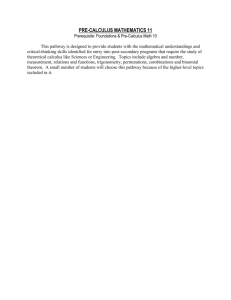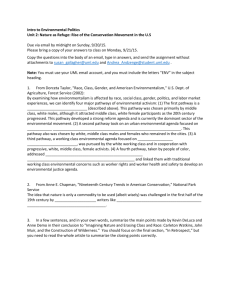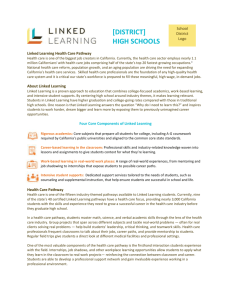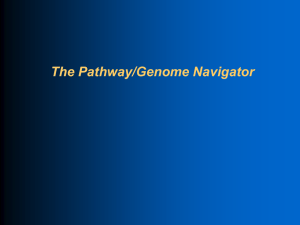Navigator tutorial script - Bioinformatics Research Group at SRI
advertisement
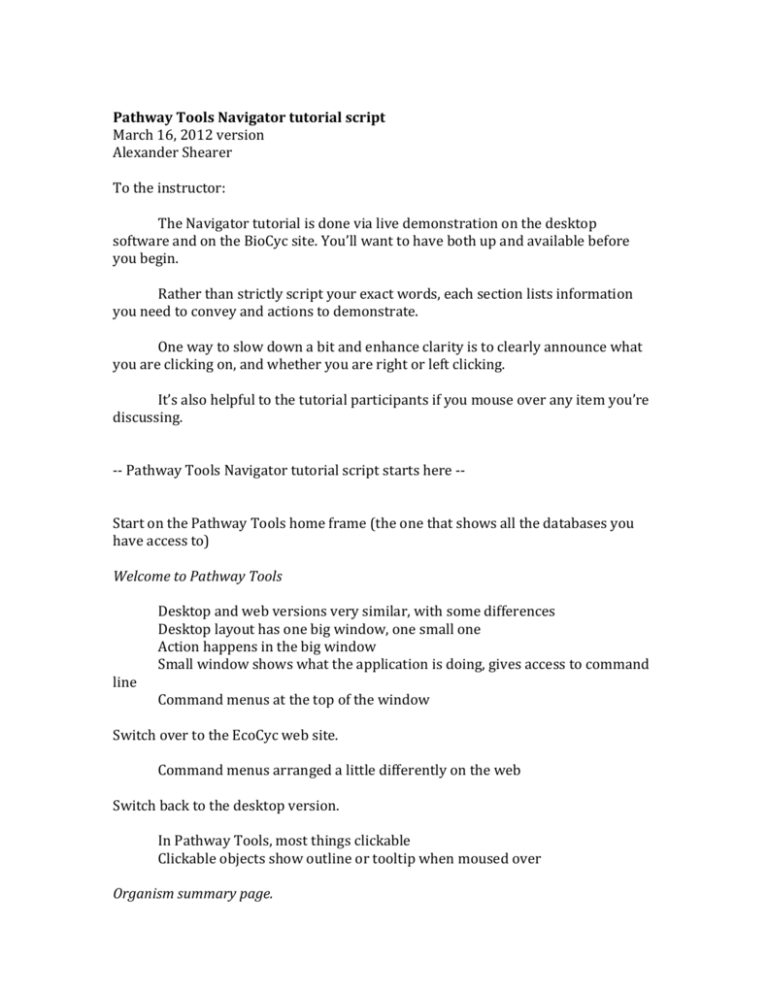
Pathway Tools Navigator tutorial script March 16, 2012 version Alexander Shearer To the instructor: The Navigator tutorial is done via live demonstration on the desktop software and on the BioCyc site. You’ll want to have both up and available before you begin. Rather than strictly script your exact words, each section lists information you need to convey and actions to demonstrate. One way to slow down a bit and enhance clarity is to clearly announce what you are clicking on, and whether you are right or left clicking. It’s also helpful to the tutorial participants if you mouse over any item you’re discussing. -- Pathway Tools Navigator tutorial script starts here -Start on the Pathway Tools home frame (the one that shows all the databases you have access to) Welcome to Pathway Tools line Desktop and web versions very similar, with some differences Desktop layout has one big window, one small one Action happens in the big window Small window shows what the application is doing, gives access to command Command menus at the top of the window Switch over to the EcoCyc web site. Command menus arranged a little differently on the web Switch back to the desktop version. In Pathway Tools, most things clickable Clickable objects show outline or tooltip when moused over Organism summary page. Click on EcoCyc. Organism summary page lists info like authors, taxonomy, summary of stats Remember that each line is clickable Click on the Pathways link Current organism. “Current organism” selector chooses where your searches look The “current organism” can be different from the one in the frame you’re currently on Easy way to search into another organism without backing up to list of organisms Moving on to object and search types There are some other universal features across multiple object types Will discuss them as we go through the individual objects Pathway searches Can search Pathways by clicking on “Pathway” in command menu Two universal searches – by name or fame, and by substring Search by name is picky – wants full, exact name Most useful if you have a frame name only to work with Search by substring is more forgiving Switch to web site Also have “quick search” on web site – looks for name across all object types Search “arginine” Quick search results grouped by object type Desktop Search by substring for “arginine” This is a multiple results menu Can click one, many, or all results Select all Answer list, back, forward, history The first answer appears in the main window, all others go on “answer list” Can click “next” for the next item on the answer list; it will appear in main window Can also use “back” and “forward” buttons to navigate, just like on a web browser Once you’ve been browsing, can look in history at recent pages History is a fast way to go back to an earlier page Use history to go back to arginine biosynthesis page What’s in a pathway page We show pathway with major intermediates and all the reaction steps Can zoom in and out Zoom in – see side compounds, names of enzymes and associated genes Zoom in again – see structure for those side compounds Can also zoom all the way out to see the “conceptual” pathway Useful if you mainly care about the pathway as a whole, like for regulation Feedback regulation shown via lines The +/- shows what the regulating factor does Genetic regulation schematic At the bottom of the page, genetic regulation schematic Shows all the genetic regulation that controls the genes for this pathway Genes grouped by operon This is a one-stop, at-a-glance view of regulation For complex features like this, note the question mark icon Click on the question mark to get a full explanation of that feature Comments and citations Notice comments, with citations Whenever you see a citation, can click on it It’ll take you to the citation within the page’s list, on the desktop – then to Pubmed entry On web, straight to Pubmed Web Pathway search Website Show web search for Pathways Can search by ontology, number of reactions (i.e. length of pathway), etc Can combine search categories Show combined search using one ontology term and a number of reactions For ontology search/filter, note number – that shows how many entries are in that category in the PGDB Desktop Reaction searches Moving on to reactions Can search by name or substring, as before Search by E.C. number Reaction frame Search for 2.6.1.11 Reaction frames pretty sparse Shows reaction with clickable compounds Lists pathways the reaction is involved in, and enzymes carrying out the reaction Note that reactions just show the molecular transformation Details about how specific enzymes do the reaction live with those enzymes In other words, reaction frame shows the molecular change, but the enzyme will talk about things like Kms, Kcats, and so forth Web site Web reaction search Like the other searches, can combine search filters Can search for combinations of reactants and products Can filter for whether or not reaction is catalyzed by an enzyme Protein search Again, search by name and substring Can also search by pathway, GO term, and a combination of weight and isoelectric point – last combo is handy with things like protein data from old papers and the results of 2D gels Protein frame pages Go to ArgD Lots of data lives in protein frames When there’s a monomer or homomultimer, we merge gene and protein Have synonyms at the top, next to… Buttons for nucleotide sequence, protein sequence, and “advanced nucleotide sequence” that lets you get nearby sequence – good for PCR primers At top of page, have an overall summary of everything that impacts the protein’s function – genetic regulators, feedback regulation, and so forth – everything Unification and other links – ways to crosslink to relevant resources, such as PDB if the protein has a crystal structure Summary text – we like to put citations right after assertions Summary captures things we don’t have formal spaces for …and has the gene-reaction schematic Gene-reaction schematic This shows the relationship between genes, proteins, and reactions Purple boxes are genes, circles are proteins, blue boxes are reactions Get a second set of boxes, with a number, for a multimer A fast way of seeing how genes, proteins, and reactions relate Notice how the ArgD gene-reaction schematic instantly tells you that ArgD carries out two reactions, and one of those is also carried out by AstC Below the gene-reaction schematic, we have GO terms and essentiality data Then… Enzymatic reactions Enzymatic reactions capture how this specific enzyme carries out a general reaction It’s where we have Kms, cofactors, and regulators that are specific to this enzyme This is how we can capture different regulatory or other data for isozymes, for example Also where we have the evidence code Evidence codes You’ll see these icons across the database Indicate how we know what we know A flask means experimental evidence, a computer means it was predicted, a book means “We think this is true, but can’t link it to other evidence” There are lots of types of evidence – for example, from a purified protein in vitro versus inferred from a mutant phenotype Gene searches, RNA searches rRNAs Can search for genes and RNAs by the usual methods Remember that gene searches will take you to combined gene/protein pages We currently represent RNAs that “work on their own,” like tRNAs and Web searches for proteins/genes/RNAs Web site Extensive options for searching and filtering Note two new options on the web – search by publication, search by protein features Search by publication is good if you want to know what knowledge was captured from a publication you just came across in your research Search by protein feature lets you find all proteins that share certain features Expand search by protein feature Expand modified-residues Select acetylation-modifications Submit query For example, here are all the proteins – 152 of them – in EcoCyc which are acetylated Multiple results on the web When you get search results like this, they appear in a sortable table Can click the arrows in each column to sort by that column Also, see the “Turn into a group” button on the upper left If you’re logged in, you can turn these results into a group and save that list for later Can do a lot with groups – more on that in the groups lesson Desktop Genetic information Search genes for argC Click on argCBG TU This is a transcription unit – most of the time, that’s the same as an operon Shows the genes in their local context, with transcription factors Promoters, transcription factor bindings sites, evidence for regulatory interactions Compound search Can search by name, substring, class, and SMILES code SMILES is a text code for an organic molecule – can be handy for looking for “features” like an aromatic ring Compounds Compound frames collect lots of info from elsewhere Show the compound names, structure, molecular formula Collects links to literally everywhere the compound appears in the database, whether that’s in reactions or as regulators or cofactors Really shows the strength of the PGDB – all the editor entered here was the compound name and an imported structure; the links come from other curation in the PGDB Website Compound web search Basically similar search here Note that monoisotopic molecular weight is useful if you’re doing mass spec InChi strings, like SMILES, are text codes for organic molecule structures Can go to lab exercises from this point


![Major Change to a Course or Pathway [DOCX 31.06KB]](http://s3.studylib.net/store/data/006879957_1-7d46b1f6b93d0bf5c854352080131369-300x300.png)
